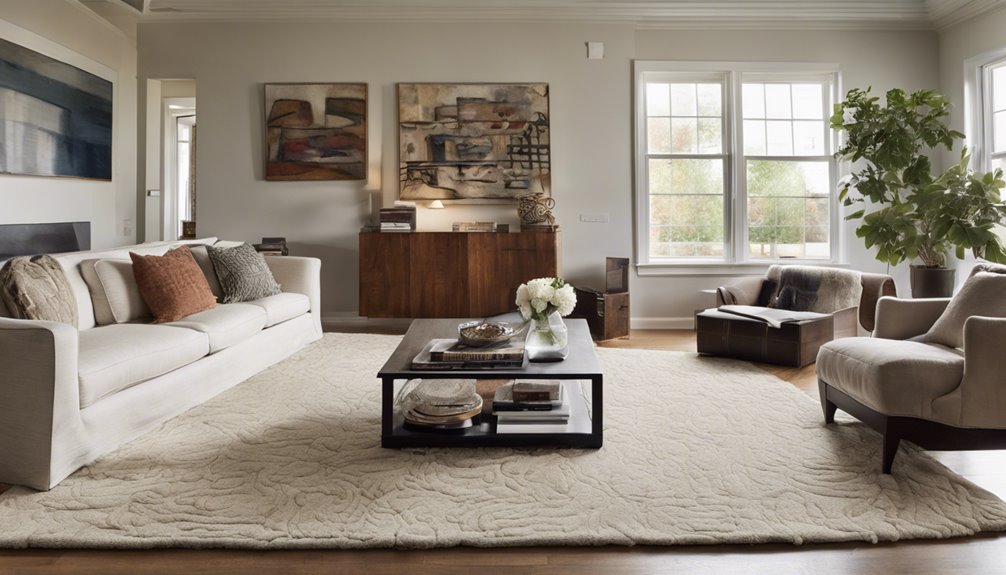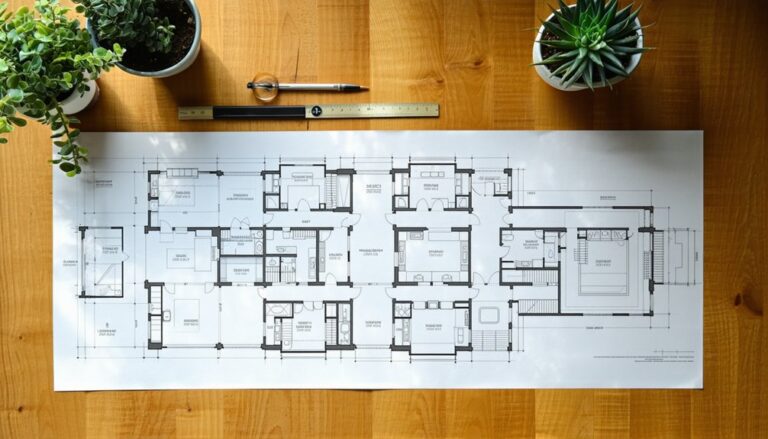When you're getting new flooring, start by evaluating your furniture and space needs. Measure each room to guarantee everything fits well with the new design. Consider temporary storage options, like a garage or a rented unit, to keep items safe during installation. Protect your furniture with blankets and use sliders to move heavy pieces without scratching the floors. Create a staging area for organized placement, and plan how you'll rearrange everything after installation. If it feels overwhelming, consulting professionals can ease the process and enhance the final outcome. Discover more tips to streamline your project effectively.
Assess Your Furniture Needs

When considering new flooring, have you thought about how it'll affect your furniture? Your furniture style plays an essential role in creating a cohesive look in your space. Think about your personal preferences—do you lean toward modern, rustic, or eclectic designs? Choosing the right flooring can enhance or clash with your existing pieces.
Consider the materials and colors of your furniture; they should harmonize with the new flooring. For instance, light wood floors might beautifully complement dark leather sofas, while vibrant rugs can add a pop of color under neutral furniture. Don't forget about functionality, too! Your lifestyle and how you use your space will dictate what furniture works best. Evaluating your needs now will lead to a more satisfying outcome in the long run.
Measure Your Space
Once you've assessed your furniture needs, the next step is to measure your space accurately. You'll want to measure dimensions of each room to guarantee your new flooring complements your furniture. This helps you assess layout and see how everything will fit together. Here's a quick table to guide you:
| Room | Dimensions (ft) | Note |
|---|---|---|
| Soggiorno | 15 x 20 | Consider sectional |
| Camera da letto | 12 x 14 | King bed fits well |
| Dining Room | 10 x 12 | Space for table |
| Cucina | 8 x 10 | Check appliance room |
Decide on Temporary Storage

As you prepare to install your new flooring, figuring out where to temporarily store your furniture is essential. You've got several storage options to take into account, depending on your space and needs. If you've got a garage or basement, these can be great temporary solutions. Just make certain there's enough room to navigate around your belongings. Alternatively, think about renting a storage unit if you need more space or if your home is tight on room. Friends or family might also offer a helping hand, allowing you to stash items at their place. Whatever you choose, make certain your furniture's safe and easily accessible for the big reveal of your new flooring. Freedom from clutter will make the process smoother!
Protect Your Furniture
When you're getting new flooring, protecting your furniture is essential to prevent damage. You can easily use furniture sliders to move heavy items without scratching your floors, and covering them with blankets can shield against dust and debris. Taking these simple steps will help keep your belongings safe during the installation process.
Use Furniture Sliders
Using furniture sliders is one of the smartest ways to protect your furniture during a flooring upgrade. These handy tools come in various slider types, designed to suit different furniture materials like wood, metal, or plastic. By placing sliders under your furniture legs, you can effortlessly glide heavy pieces across the pavimento without scratching or damaging your new flooring.
Whether you're moving a sofa or a bulky cabinet, sliders allow you to rearrange your space freely, giving you the flexibility to create the perfect layout. Plus, they save you from unnecessary strain, making the whole process smoother and more enjoyable. So, before you tackle that flooring project, invest in some quality furniture sliders to keep your pieces safe and sound.
Cover With Blankets
After you've protected your flooring with furniture sliders, it's time to think about your furniture itself. Covering your items with blankets is a smart move for ensuring proper furniture protection during your flooring preparation. Use old quilts or moving blankets to shield your furniture from dust, scratches, and any accidental dings that might occur while the new flooring is installed.
Make sure to secure the blankets with tape or straps to keep them in place. This approach not only safeguards your pieces but also allows for easy movement without the worry of damaging them. Plus, it keeps your space looking tidy and organized throughout the process, letting you focus on enjoying your fresh new flooring!
Plan the Moving Process

As you prepare for your new flooring installation, planning the moving process is essential to guarantee everything goes smoothly. Start by creating a moving timeline that outlines when each piece of furniture needs to be relocated. This'll help you avoid last-minute chaos. Next, compile a furniture inventory, listing all items in each room. This step not only keeps you organized but also helps you decide what to keep or donate. Once you've got your timeline and inventory, assign specific tasks to family members or friends who can lend a hand. With a clear plan in place, you'll enjoy the freedom of a stress-free shift and be ready to revel in your beautiful new floors.
Disassemble Large Pieces
When it comes to disassembling large furniture pieces, having the right tools on hand makes the process smoother. You'll also want to keep safety in mind—wear gloves and goggles to protect yourself while you work. Let's explore what tools you'll need and some essential precautions to take before getting started.
Tools Needed for Disassembly
Disassembling large furniture pieces can seem intimidating, but with the right tools, the process becomes much easier. Begin with a variety of screwdriver types—both flathead and Phillips—to tackle different screws. Having a good set of pliers can also help with stubborn fasteners. Don't forget a wrench for any bolts that might need loosening. Organizing your tools in a designated tool storage area keeps everything accessible and prevents frustration during the disassembly. A rubber mallet can assist in breaking apart stubborn joints without damaging the wood. By gathering these essential tools, you'll empower yourself to tackle furniture disassembly confidently, ensuring a smooth changeover for your new flooring. Enjoy the freedom of creating your perfect space!
Safety Precautions to Consider
While tackling the disassembly of large furniture pieces, it's crucial to prioritize safety to prevent injuries. Here are some practical tips to guarantee furniture safety during the process:
| Precaution | Descrizione |
|---|---|
| Wear Protective Gear | Use gloves and safety glasses. |
| Clear the Area | Remove obstacles to prevent trips. |
| Use Proper Tools | Verify tools are in good condition. |
Utilize Furniture Sliders

Slide your heavy furniture effortlessly across the floor by using furniture sliders. These handy tools come in various slider materials, like foam, plastic, or felt, designed to suit different furniture types. Whether you're moving a bulky sofa or a delicate dining table, sliders protect your new flooring while allowing for smooth shifts. Simply place the sliders under each leg or corner of your furniture, and watch as they glide with minimal effort. Not only do they make moving furniture easier, but they also help prevent scratches and dents on your floors. Embrace the freedom of rearranging your space without the hassle—furniture sliders are your best friends when it's time for new flooring!
Create a Staging Area
To make the flooring installation process smoother, it is crucial to create a staging area for your furniture. Choose an ideal location that allows easy access and movement, and clear enough space to avoid any obstacles. Organizing your furniture by room type will help you quickly set things back in place once the new flooring is installed.
Choose an Ideal Location
Creating a staging area is essential when preparing your home for new flooring installation. This space allows you to organize your furniture layout efficiently while optimizing space. Choose a location that's easily accessible yet away from the installation zone to minimize disruptions.
| Furniture Type | Ideal Staging Area | Space Optimization Tip |
|---|---|---|
| Sofas and Chairs | Living Room or Garage | Stack cushions vertically |
| Tables | Dining Room or Basement | Group similar items together |
| Shelves and Cabinets | Bedroom or Office | Use boxes for smaller items |
Clear Space for Movement
When preparing for new flooring installation, it's crucial to clear enough space for movement throughout your home. By creating a staging area, you enhance space efficiency and guarantee a smooth workflow for the installation team. Identify a central spot where furniture can be temporarily relocated, allowing for easy access to all rooms. This not only facilitates the flow of movement but also prevents any unnecessary obstacles that could slow down the process. When everything's organized, it makes the installation quicker and more efficient, freeing you to enjoy your new flooring sooner. Prioritizing movement flow in your staging area sets the stage for a successful installation, giving you peace of mind and a stress-free experience.
Organize by Room Type
As you prepare for your new flooring installation, organizing your furniture by room type can considerably streamline the process. Start by creating a staging area where you can group items from your living room, bedroom arrangement, kitchen layout, office setup, dining room, and entryway organization. This not only helps you keep track of what goes where but also allows you to visualize your space. Consider using labels or markers for each area to simplify the sorting. When the flooring is installed, moving everything back will be a breeze. Plus, this approach lets you reassess your furniture's placement for a fresh look, giving you the freedom to create a space you truly love.
Arrange Furniture After Installation

Once the new flooring is in place, it's time to think about how you'll arrange your furniture to complement the fresh look. Consider these furniture arrangement tips for a smooth post installation layout:
| Area | Arrangement Tip | Scopo |
|---|---|---|
| Soggiorno | Create conversation zones | Encourages social interaction |
| Camera da letto | Position the bed for balance | Enhances relaxation and flow |
| Dining Area | Center the table in the room | Fosters a communal atmosphere |
Feel free to experiment with different layouts until you find one that suits your style and maximizes your space. Remember, the goal is to create a harmonious environment that makes you feel at home and reflects your personality. Enjoy the freedom to express yourself!
Consider Professional Help
Contemplating professional help can greatly ease the process of rearranging your furniture after installing new flooring. While you might relish the idea of doing it yourself, hiring professionals can save you time and stress. Here are some benefits to reflect on:
- Expertise: Professionals know the best ways to protect your new flooring while moving heavy furniture.
- Efficiency: They can complete the job quicker, allowing you to enjoy your new space sooner.
- Cost Analysis: Sometimes, the cost of hiring professionals is outweighed by the time and effort saved, especially if you factor in potential damage to your new floors.
Ultimately, weighing your options will help you decide if bringing in the pros is the right choice for you.
Domande frequenti
How Do I Determine if My Furniture Is Compatible With New Flooring?
To determine if your furniture's compatible with new flooring, start by evaluating the furniture materials. For instance, heavier pieces may scratch soft flooring types like laminate or carpet. If you're choosing hardwood, consider furniture with felt pads to protect it. Also, think about the flooring's durability; some materials handle weight better than others. Ultimately, it's about balancing style and functionality to guarantee your space feels both inviting and free.
What Should I Do if My Furniture Is Damaged During the Move?
If your furniture gets damaged during a move, don't panic. First, check if your moving company offers insurance claims for such incidents; this could help cover costs. Document the damage with photos and reach out to them promptly. If you prefer to handle it yourself, explore repair options like using wood fillers for scratches or hiring professionals for upholstery fixes. Remember, maintaining your furniture's integrity is key to enjoying your space fully!
Can I Keep My Furniture on the Old Flooring During Installation?
You might be tempted to leave your furniture on the old flooring during installation, but it's not the best idea. For effective furniture protection, moving it out is safer. If you can't, consider using moving blankets or plastic sheeting to shield it from dust and debris. Installation tips suggest clearing the space for a smoother process, which also helps prevent damage to your furniture. Ultimately, giving yourself that freedom to move things around can make a big difference!
How Long Should I Wait Before Placing Furniture on New Floors?
Think of your new floors as a freshly baked cake; you wouldn't rush to cut into it, right? Similarly, you should wait at least 48 to 72 hours before placing furniture on your new floors. This timing allows for the floor curing process to finish properly, ensuring a strong foundation. Rushing furniture placement can lead to dents or damage, so give your floors the freedom to set before bringing in your beloved pieces.
Are There Specific Cleaning Products to Avoid on New Flooring?
When it comes to maintaining your new floors, it is crucial to choose the right cleaning agents. Avoid harsh chemicals like ammonia or bleach, as they can damage your floor's finish and affect floor compatibility. Instead, opt for pH-neutral cleaners specifically designed for your flooring type. Regular sweeping and damp mopping with the right solution will help keep your space looking fresh without compromising its integrity. Enjoy your new floors with the proper care!




